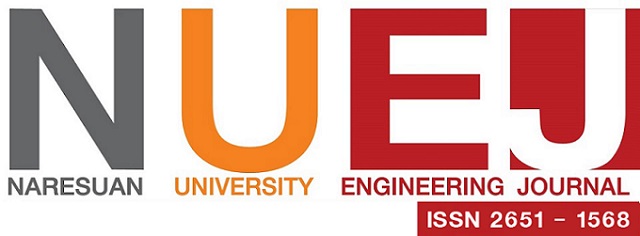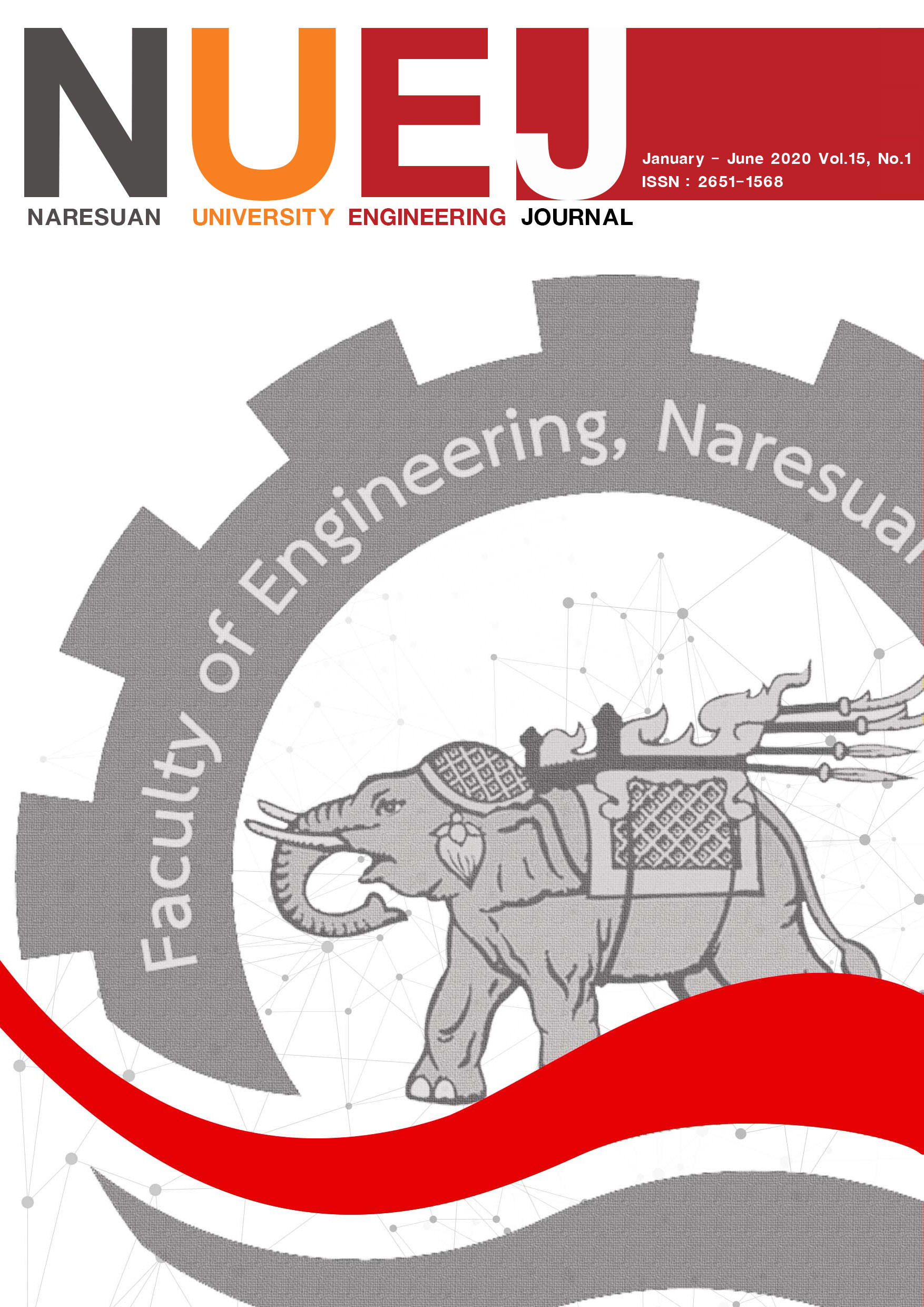การประยุกต์ใช้เทคนิคการจำลองสถานการณ์แบบมอนติคาร์โลเพื่อการจัดการอะไหล่สำหรับการบำรุงรักษาในอุตสาหกรรมปิโตรเลียม
Main Article Content
บทคัดย่อ
งานวิจัยนี้มีวัตถุประสงค์เพื่อวิเคราะห์หาปริมาณการสั่งซื้ออะไหล่ที่เหมาะสมสำหรับใช้ในงานบำรุงรักษาในอุตสาหกรรมปิโตรเลียม โดยประยุกต์ใช้แบบจำลองสถานการณ์แบบมอนติคาร์โล ปัจจุบันโรงงานกรณีศึกษาประสบปัญหาการมีต้นทุนการจัดการอะไหล่ที่สูง เนื่องจากการจัดซื้ออะไหล่ยังไม่มีระบบการจัดการสั่งซื้อที่ดี ยังใช้การคาดการณ์เป็นเกณฑ์ในการสั่งซื้อ ซึ่งส่งผลให้อะไหล่บางชนิดมีการจัดเก็บที่มากเกินไป ดังนั้นคณะผู้วิจัยจึงได้เสนอนโยบายเพื่อหาปริมาณการสั่งซื้อที่เหมาะสมภายใต้ความต้องการที่ไม่แน่นอนที่ส่งผลให้ต้นทุนรวมต่ำที่สุด ขั้นตอนการวิจัยเริ่มจากการวิเคราะห์หาระดับความสำคัญของอะไหล่ด้วยการจัดกลุ่มอะไหล่แบบ ABC และเลือกศึกษาเฉพาะอะไหล่ที่อยู่ในกลุ่ม A โดยคิดเป็นร้อยละ 80.34 ของมูลค่าอะไหล่ทั้งหมด งานวิจัยนี้กำหนดนโยบายสินค้าคงคลังเป็น 2 แบบ คือ (s,Q) และ (s,S) เนื่องจากลักษณะการตรวจสอบอะไหล่ของโรงงานกรณีศึกษาเป็นแบบต่อเนื่อง โดยประยุกต์ใช้แบบจำลองสถานการณ์แบบมอนติคาร์โล พบว่านโยบายที่ทำให้ปริมาณการสั่งซื้ออะไหล่ที่เหมาะสมที่สุดภายใต้ต้นทุนรวมที่ต่ำที่สุดคือ นโยบายแบบ (s,S) จากนั้นนำผลลัพธ์ที่ได้ไปเปรียบเทียบกับแผนการสั่งซื้อเดิมของโรงงานกรณีศึกษา พบว่าโนบาย แบบ (s,S) มีต้นทุนรวมเท่ากับ 75,394,160 บาทต่อปี และเดิมโรงงานมีต้นทุนรวมเท่ากับ 96,357,062 บาทต่อปี ดังนั้นผลที่ได้จากการใช้เทคนิคการจำลองสถานการณ์แบบมอนติคาร์โลสามารถลดต้นทุนรวมของการจัดการอะไหล่ได้เท่ากับ 20,962,902 บาทต่อปี หรือลดลงร้อยละ 21.76 อย่างมีนัยสำคัญทางสถิติที่ระดับความเชื่อมั่น 95 เปอร์เซ็นต์
Article Details
References
Collado, J., Falco, A., Rodrigo, D., Sampedro, F., Consuelo, M., & Martinez, A. (2011). Application of Monte Carlo Simulation in Industrial Microbiological Exposure Assessment. In S. Mordechai (Ed.), Applications of Monte Carlo Method in Science and Engineering (pp. 83-94). InTech. https://www.intechopen.com
Furness, P. (2011). Applications of Monte Carlo Simulation in marketing analytics. Direct Data Digit Mark Pract, 13(2), 132–147. https://doi.org/10.1057/dddmp.2011.25
Gutiérrez, J., Sedeño-Noda, A., Colebrook, M., & Sicilia, J. (2003). A new characterization for the dynamic lot size problem with bounded inventory. Computers & Operations Research, 30(3), 383–395. https://doi.org/10.1016/S0305-0548(01)00105-8
Han, H. J., Kim, B. K., & Park, B. G. (2018). Monte Carlo simulation of gamma-ray distribution around spent nuclear fuel assembly using a fiber-optic Cerenkov radiation sensor. Journal of Radioanalytical and Nuclear Chemistry, 316(3), 1189–1193. https://doi.org/10.1007/s10967-018-5785-5
Ivanov, D., Tsipoulanidis, A., & Schönberger, J. (2017). Inventory Management. In D. Ivanov, A. Tsipoulanidis, & J. Schönberger (Eds.), Global Supply Chain and Operations Management (pp. 345–388). Springer International Publishing.
Jintaketkarm, P. (2012). The Application of Monte Carlo Technique for Optimizing order Quantity Policy: A Case Study in Light Bulb Industry [Master’s thesis]. Department of Industrial Engineering, Facuty ofKing Mongkut’s University of Technology North Bangkok.
Kampf, R., Hitka, M., & Caha, Z. (2016). The Application of ABC Analysis to Inventories in the Automatic Industry Utilizing the Cost Saving Effect. Naše More, 63(3), 120–125.
Leepaitoon, S., & Bunterngchit, C. (2019). The Application of Monte Carlo Simulation for Inventory Management: A Case Study of a Retail Store. International Journal of the Computer, the Internet and Management, 27, 67–83.
Lordahl, A., & Bookbinder, J. (1994). Order‐statistic calculation, costs, and service in an (s, Q) inventory system. Naval Research Logistics (NRL), 41, 81-97. https://doi.org/10.1002/15206750(199402)41<81::AIDNAV3220410106>3.0.CO;2-9
Malindzakova, M., & Zimon, D. (2019). Design Supply Cycle for Inventory Management. TEM, 8(3), 894–899. https://doi.org/10.18421/TEM83-29
Medeiros, M. (2005). Monte Carlo simulation of polarizable systems: Early rejection scheme for improving the performance of adiabatic nuclear and electronic sampling Monte Carlo simulations. Theoretical Chemistry Accounts, 113(3), 178–182.
Ohta, H., Hirota, T., & Rahim, A. (2007). Optimal production-inventory policy for make-to-order versus make-to-stock based on the M/Er/1 queuing model. The International Journal of Advanced Manufacturing Technology, 33(1–2), 36–41.
Ozkan, O., & Kilic, S. (2019). A Monte Carlo Simulation for Reliability Estimation of Logistics and Supply Chain Networks. IFAC-PapersOnLine, 52(13), 2080–2085. https://doi.org/10.1016/j.ifacol.2019.11.512
Penpakkol, P., & Intarakumthorncha, T. (2018). Inventory Management of Spare Parts under Uncertain Demand: A Case Study of Particle Board Manufacturer. The Journal of King Mongkut’s University of Technology North Bangkok, 21(1), 9-22.
Phupha, V. (2014). An Application of Monte Carlo Simulation for Optimal Order Quantity: A Case Study of Raw Materials Procurement in Processed food Industry. Kasetsart Engineering Journal, 88, 41–56.
Porras, E., & Dekker, R. (2008). An inventory control system for spare parts at a refinery: An empirical comparison of different re-order point methods. European Journal of Operational Research, 184, 101–132. https://doi.org/10.1016/j.ejor.2006.11.008
Resteanu, C., Vaduva, I., & Andreica, M. (2008). Monte Carlo Simulation for Reliability Centered Maintenance Management. In I. Lirkov, S. Margenov, & J. Waniewski (Eds.), Large-Scale Scientific Computing Vol. 4818 (pp. 148–156). Springer Berlin Heidelberg.
Sedtakomkul, N. (2011). The Applied Monte Carlo Simulation Method to Reorder Point and Order Quantity for Purchasing Under Uncertainties of Demand [Master’s thesis]. Department of Industrial Engineering, Facuty ofKing Mongkut’s University of Technology North Bangkok.http://www.ijcim.th.org/past_editions/2019V27N2/27n2Page76.pdf
Sorkhabi, R. (2017). Petroleum Industry. In R. Sorkhabi (Ed.), Encyclopedia of Petroleum Geoscience (pp. 1–2). Springer International Publishing.
Tamura, M., Morizawa, K., & Nagasawa, H. (2010). Dynamic robust optimal reorder point with uncertain lead time and changeable demand distribution. Journal of Zhejiang University-SCIENCE A, 11(12), 938–945.
Van Horenbeek, A., & Pintelon, L. (2015). A Joint Predictive Maintenance and Inventory Policy. In P. W. Tse, J. Mathew, K. Wong, R. Lam, & C. N. Ko (Eds.), Engineering Asset Management—Systems, Professional Practices and Certification (pp. 387–399). Springer International Publishing. https://doi.org/10.1007/978-3-319-09507-3_34
Xu, N. (2017). Optimal inventory policy for a dynamic stochastic inventory problem with order revision. Optimization Letters, 11(7), 1489–1497.

